- Home
- Medical news & Guidelines
- Anesthesiology
- Cardiology and CTVS
- Critical Care
- Dentistry
- Dermatology
- Diabetes and Endocrinology
- ENT
- Gastroenterology
- Medicine
- Nephrology
- Neurology
- Obstretics-Gynaecology
- Oncology
- Ophthalmology
- Orthopaedics
- Pediatrics-Neonatology
- Psychiatry
- Pulmonology
- Radiology
- Surgery
- Urology
- Laboratory Medicine
- Diet
- Nursing
- Paramedical
- Physiotherapy
- Health news
- Fact Check
- Bone Health Fact Check
- Brain Health Fact Check
- Cancer Related Fact Check
- Child Care Fact Check
- Dental and oral health fact check
- Diabetes and metabolic health fact check
- Diet and Nutrition Fact Check
- Eye and ENT Care Fact Check
- Fitness fact check
- Gut health fact check
- Heart health fact check
- Kidney health fact check
- Medical education fact check
- Men's health fact check
- Respiratory fact check
- Skin and hair care fact check
- Vaccine and Immunization fact check
- Women's health fact check
- AYUSH
- State News
- Andaman and Nicobar Islands
- Andhra Pradesh
- Arunachal Pradesh
- Assam
- Bihar
- Chandigarh
- Chattisgarh
- Dadra and Nagar Haveli
- Daman and Diu
- Delhi
- Goa
- Gujarat
- Haryana
- Himachal Pradesh
- Jammu & Kashmir
- Jharkhand
- Karnataka
- Kerala
- Ladakh
- Lakshadweep
- Madhya Pradesh
- Maharashtra
- Manipur
- Meghalaya
- Mizoram
- Nagaland
- Odisha
- Puducherry
- Punjab
- Rajasthan
- Sikkim
- Tamil Nadu
- Telangana
- Tripura
- Uttar Pradesh
- Uttrakhand
- West Bengal
- Medical Education
- Industry
Bright nights, higher diabetes risk: Dimming lights may mitigate this risk, study suggests

Australia: A recent study published in The Lancet revealed that individuals exposed to the most light between 12:30 AM and 6 AM were 1.5 times more likely to develop diabetes than those who stayed in darkness during those hours.
"We found a higher risk of type 2 diabetes (T2D) in people exposed to brighter night light, and in people exposed to light patterns that may disrupt circadian rhythms," the researchers wrote, "suggesting, "Avoiding light at night could be a simple and cost-effective strategy to reduce diabetes risk, even for individuals with a high genetic predisposition."
Exposure to light at night disrupts circadian rhythms, which is a known risk factor for type 2 diabetes. Whether exposure to personal light predicts diabetes risk has not been demonstrated in a large prospective cohort. Considering this, Daniel P. Windred, Monash University, Melbourne, VIC, Australia, and colleagues assessed whether personal light exposure patterns predicted incident T2D risk in UK Biobank participants, using ∼13 million hours of light sensor data.
For this purpose, 84,790 participants (median age = 62.3 years, 58% female) wore light sensors for one week, recording day and night light exposure. Circadian amplitude and phase were modeled using weekly light data.
A total of 1,997 cases of incident type 2 diabetes were documented over an average follow-up of 7.9 ± 1.2 years, excluding cases diagnosed before light tracking began. The risk of developing type 2 diabetes was evaluated based on daytime and nighttime light exposure, circadian phase, and amplitude while controlling for age, sex, ethnicity, socioeconomic status, lifestyle factors, and polygenic risk.
The study led to the following findings:
· Compared to people with dark nights (0–50th percentiles), diabetes risk was incrementally higher across brighter night light exposure percentiles (50–70th: multivariable-adjusted HR = 1.29; 70–90th: 1.39; and 90–100th: 1.53).
· Diabetes risk was higher in people with lower modeled circadian amplitude (aHR = 1.07 per SD) and with early or late circadian phase (aHR range: 1.06–1.26).
· Night light and polygenic risk independently predicted higher diabetes risk.
· The difference in diabetes risk between people with bright and nights was similar to the difference between people with low and moderate genetic risk.
The findings show that maintaining a dark environment during the night may reduce the risk of type 2 diabetes development, likely due to the disruptive effects of light at night on circadian rhythms.
"Encouraging individuals to turn off lights at night or use dim, "warm" lighting to minimize circadian disruption is a simple, cost-effective, and easily implemented recommendation that could enhance cardiometabolic health and help alleviate the increasing global burden of type 2 diabetes.," they concluded.
Reference:
DOI:https://doi.org/10.1016/j.lanepe.2024.100943
Dr Kamal Kant Kohli-MBBS, DTCD- a chest specialist with more than 30 years of practice and a flair for writing clinical articles, Dr Kamal Kant Kohli joined Medical Dialogues as a Chief Editor of Medical News. Besides writing articles, as an editor, he proofreads and verifies all the medical content published on Medical Dialogues including those coming from journals, studies,medical conferences,guidelines etc. Email: drkohli@medicaldialogues.in. Contact no. 011-43720751


